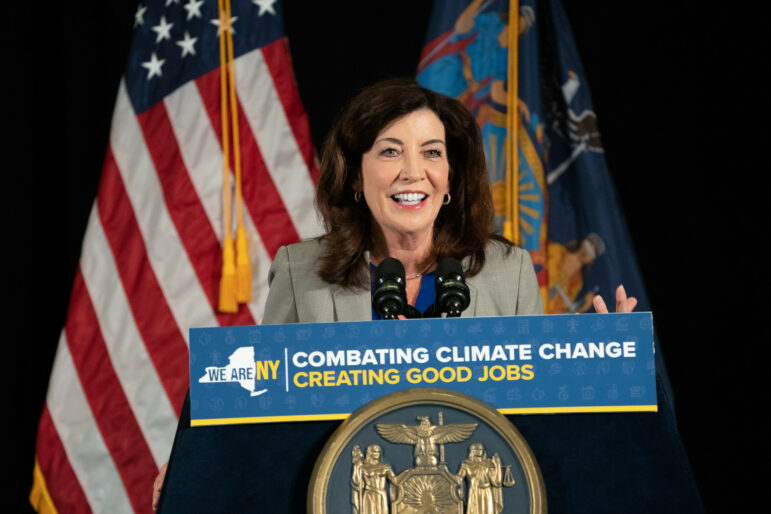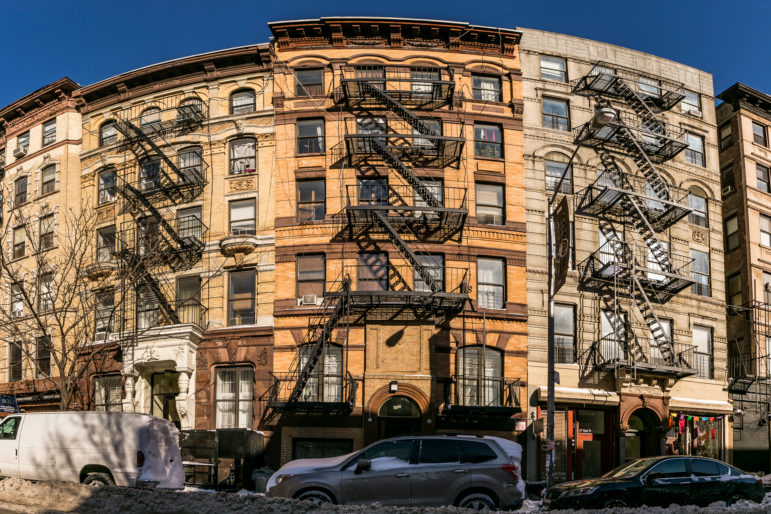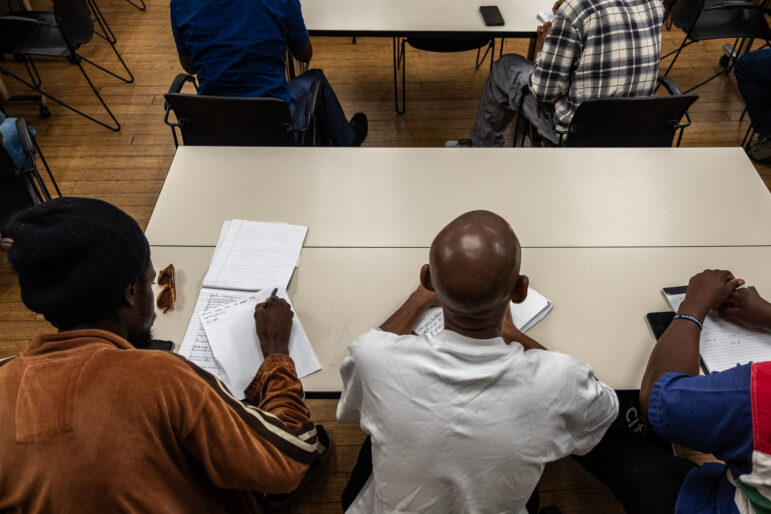
Devin Holt
The Jollibee mascot in front of the company’s only New York City location in Woodside, Queens.
The U.S. debate about border and citizenship policy revolves around a picture of immigration painted in broad strokes: images of Syrian refugees massing at Europe’s borders or a stream of people flowing across the desert from Mexico to Texas, language about surges, threats, heroes and dreams. Like any sweeping generalizations, those characterizations gloss over the details and nuances the define each immigrant’s individual story. More importantly, they pay little attention to what happens once an immigrant makes it into our country.
As the stories below, reported by students at the CUNY Graduate School of Journalism, make clear, immigrant life in New York is neither the deviant existence imagined by xenophobes nor the sepia-toned immigration myth harbored by some of those who welcome the newcomers. It’s a fast-food restaurant that provides a link to the familiar, the thrill of political progress at home mixed with the realization that there’s no going back, the double marginalization of being undocumented and transgender. It’s overstaying a visa, or trying to survive according to the onerous rules that some visas impose. It’s trying to navigate a global economic crisis or make a living in a dying industry.
Immigrant life in New York is a lot of things. One thing it isn’t is simple.
Jollibee in Queens: Tastes like the Philippines, Tastes like America
by Devin Holt
Census data show 58,000 people from the Philippines live in New York City, and they all have to share the same Jollibee.
“I’ve been there so many times,” says Robert Bacaycay, a chef* and publisher of the blog “Filipinos of New York,” who lives in Woodside, Queens, two blocks from the Jollibee. “I went there last week.”
A fast food chain known for chicken, gravy and a red and white mascot that looks like a mashup of Barney the dinosaur and a red Power Ranger, Jollibee is often called the McDonald’s of the Philippines. The first one opened in Cubao, near Manila, in 1975. It was originally an ice cream parlor, according to the company’s website, and has since grown into the Philippine’s largest fast-food chain.
Jollibee is less popular in the U.S., but its mostly-Filipino customers remain very, very loyal. It’s more than a restaurant to them. Jollibee is, as the company likes to put it, “a taste of home,” and a point of ethnic pride for a group whose homeland rarely gets U.S. media attention when Manny Pacquiao isn’t boxing.
The Woodside branch was the first Jollibee on the East Coast. It opened on a cold, windy morning in February 2009. Philippe Garcesto, a manager on opening day, says the line to get in started at 5 a.m. and included Filipinos who traveled from Chicago, Philadelphia and New Jersey, as well as his mother, who gave up after waiting for an hour.
“It was bananas,” Garcesto, 30, says. “And that was just the first week.” The lines continued for a month, he says.
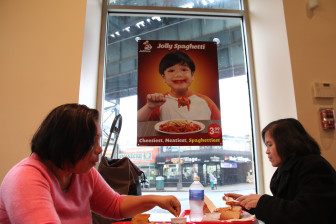
Devin Holt
Helen Himbing, 58, (right) a home health aide who said she comes to Jollibee every day, and her friend enjoy a meal in New York City’s only Jollibee location in Woodside, Queens.
Dedication to a popular restaurant from home isn’t unusual for immigrants, says Nancy Foner, a distinguished professor of Sociology at Hunter College. But Foner says Jollibee sounded like a unique case because much of the menu — burgers, fries, chicken, spaghetti — are traditional American staples.
“It’s an interesting dynamic because you have an American import in the Philippines, and then in time it’s been imported back to America as something from the Philippines,” Foner says.
Bacaycay says the company manages its cross cultural culinary trick by serving Filipino versions of western dishes.
“There is something Asian-ey in the recipe of the chicken,” Bacaycay says. “It’s juicy. It’s different from Kentucky or any other fast food.”
The key to a successful Jollibee visit, on both sides of the Pacific, Bacaycay says, is to order the chicken and get extra gravy. Loyal fans use the gravy as a dipping sauce and then pour it over the rice when the chicken is finished.
“They love the gravy,” Bacaycay says. “They ask for extra gravy always.”
Two pieces of Chickenjoy — the company’s most popular item, Dianne Yorro, a spokeswoman says — ordered with gravy on a recent Wednesday did not taste distinctively Asian to this reporter, who was born and raised in Paducah, Kentucky. But it didn’t taste exactly like KFC either, and it was juicy. The meal came with a soda, rice and heavily-buttered corn. It was served on a bright red tray in less than one minute.
Another popular dish is spaghetti. It’s served Filipino-style, with a sweet, tomato-based sauce. That’s what Helen Himbing, a home health care aide who lives in Woodside, ordered. Himbing, 58, says she goes to Jollibee every day. It’s been 11 years since she moved to the U.S. from the Philippines, Himbing says, and she still hasn’t gone back for a visit. But she can always get a taste of home at Jollibee.
“It’s the same,” Himbing says. “Everything is the same. This is Filipino food.”
Glendale’s Burmese Baptists Look Back at Their Native Land as Democracy Rises There
When Reverend U Myo Maw took the pulpit at the Myanmar Baptist Church in Glendale on the Sunday before Thanksgiving, his sermon about having “a thankful heart” drew standing applause and wide grins. Such happiness mirrors that of the congregation’s feelings about the recent landslide victory in Myanmar of the National League for Democracy party, led by Aung San Suu Kyi.
Aung San Suu Kyi’s victory is the first truly democratic election in the former British colony that has experienced decades of sectarian, ethnic, and military conflict. Rev. U Myo Maw, who once considered a career in the military, was most effusive about the change that democracy is bringing to Myanmar. He proudly proclaimed that the country would finally have “a civilian government of elected people.”
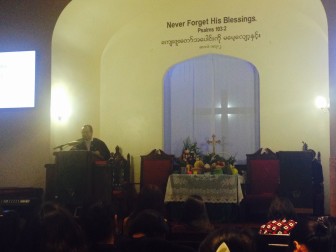
Everic White
Inside the Myanmar Baptist Church in Glendale.
U Myo Maw and his congregation worship in the middle of Community District 5’s Glendale, which is 80 percent white. But the services at Myanmar Baptist Church are done completely in Burmese, and U Myo Maw wears a traditional longyi, the cloth skirt worn by both men and women.
After the services, the church serves a generous luncheon including traditional Burmese cuisine like Meeshay, a dish of rice noodles in pork or beef sauce. “We will always remember our Burmese culture. That starts with language, clothing, and food,” says U Myo Maw.
But the minister who came to this country 15 years ago, and others in his congregation are uncertain how welcome they would be in their homeland. Unlike in Glendale, which is nearly 90 percent Christian, Christianity in Myanmar is rare.
“If you are not Buddhist, it is difficult to get ahead,” U Myo Maw says, noting that 90 percent of that country practices Buddhism. “There is a lot of mistrust among the Burmese regarding Christianity.” That mistrust is a result of the British colonizing the country via a triumvirate of what U Myo Maw calls the Three M’s: the merchants, the military, and the missionaries.
Since leaving the British Empire after World War II, Myanmar has had a series of military rulers, socialist regimes, and civil wars, ending in a 2008 constitutional referendum. Though some at the church see the election of Aung San Suu Kyi’s party as a step in the right direction, they say they are skeptical of rapid reform.
“We are not sure what’s going to happen next,” says U Taja Labang, president of the Myanmar Baptist Church. “We’re expecting good things, but not for another six months, until the new government can come on to train up a new constitution.”
As his former nation begins a new democracy, U Tuja Labang says he was also happy to be living in an established democracy. “This is the perfect place to raise our children so that they can get an education,” he says.
Both U Myo Maw and U Tuja Labang say they were unlikely to return to Myanmar. “It was hard enough to win the lottery to come to America,” says U Tuja Labang. However he admitted that “There is much more opportunity in Myanmar in the last decade, and some are going back.”
But U Myo Maw added with a laugh, “as in Manhattan, the cost of living is very high.”
Visa Restrictions Squeeze Foreign Students
by Shane English
Solene came to the U.S. from France with a scholarship to study at the Manhattan Institute of Management and enough money to cover her rent but she was unprepared for just how expensive it is to live in New York City.
“My school and apartment are paid for,” the 20-year-old, who asked that her last name be concealed, says. “But without work, I don’t know what I would eat or what I would do in the city.”
The F1 student visa requires foreign students to arrive in the U.S. with enough money to pay tuition and expenses for the duration of their education, according to the U.S. Citizen and Immigration Services. But for all but the wealthiest of students, the stipulations of the F1 visa can lead students into difficult financial circumstances and the opaque world of illegal employment.
The law governing F1 visas is clear: “Any unauthorized employment by a nonimmigrant constitutes a failure to maintain status” (from Title 8 of the Code of Federal Regulations). Students who do not maintain status can face deportation per the Immigration Reform and Control Act of 1986.But many students flout the rule to make ends meet. Solene works as a nanny and a housekeeper. Seeking employment was difficult at first. “I didn’t know who to ask at school,” she says. “I didn’t know if it was bad to get a job.”
She says another student told her about les Frenchy, a website that hosts classified ads and caters to the French community in New York. Through les Frenchy, she found the families she now works for.
Though her work situation is precarious, Solene says that she isn’t worried about getting in trouble with her school or with U.S. Immigration and Customs Enforcement.
“I work in the homes of two French families,” she says. “If I am caught I can just say that they are my cousins.” Solene says that she is not anxious. But she fidgets when asked about the legality of her work. She says she has classmates who work in restaurants and shops who are at a greater risk of being caught because their jobs face the public. “My friend is Chinese and she works at a clothes cleaners near her apartment,” she says. “She is always nervous that she will be asked to prove that she can work here.”
There are few alternatives for these students. On campus employment is limited and subject to approval from the immigration department, says Ashima Nayar, the admissions coordinator for MIM. Students are permitted to work after their first year in the country but are still heavily restricted: they can only work in an industry connected to their studies.
Marion, 20, is a classmate of Solene’s who also declined to give her last name because she is working illegally. “I work in a café waiting tables,” she says. “My hours change all the time but how can I complain?”
Marion says she worries that her position leaves her vulnerable to unfair working conditions. “I’ve been told that I have to work twice as long as I was scheduled,” she says. “I don’t know who I could tell.”
Undocumented Transgender Immigrants Face Double the Discrimination in the Workplace
When sitting down with Joselyn Mendoza, one cannot help but admire her seemingly effortless look. The caramel sheen of her hair has a subtle ombré highlighting, and her soulful eyes have been shadowed by two perfectly symmetrical sweeps of cobalt liner; precision like this would require a needlelike accuracy.
It is not surprising to learn that Mendoza, who has been studying at the cosmetology Formula B Parisien School in Woodside, Queens, has been maintaining a 92 percent GPA since enrollment. She will be a fully licensed cosmetologist by late December, and though it took some time, she will soon be in possession of a license with her true identity on it.
Mendoza is a 42-year-old transgender undocumented immigrant originally from Cuautla, Mexico. She came to New York City in 1998 when she was 24 years old to escape a culture that, she described, was threatening to her safety.
“My expectation was that I’d be accepted, but when I got here, I realized that it was going to be an obstacle,” says Mendoza, describing her initial experiences as a transgender woman in Queens.
The National Center for Transgender Equality (NCTE) reports that anywhere between 15,000 and 50,000 undocumented immigrants are transgender. The NCTE concedes that these numbers could in fact be much higher, but transgender people are afraid to out themselves.
This is not surprising. Jackie Yodashkin, the communications director at Immigration Equality, a national advocacy and legal support organization for LGBT immigrants, says that both transgender and undocumented immigrants face higher threats of employment discrimination.
This kind of double-marginalization in the working world is something that Mendoza has become all too familiar with.
“The first job I had, I was fired because one of my co-workers complained after noticing changes in my breasts,” explains Mendoza. “The second job I had, my boss actually beat me up in front of my coworkers after I refused to work an extra hour after my 12-hour shift.”
Mendoza says that there are other, often not thought about, unique barriers put in place for transgendered undocumented immigrants that are on the job hunt.
“I had to choose to either hide my identity and dress up as a man or not get called back,” says Mendoza. Her government issued I.D. from Mexico has her listed with a male name and her gender as a man.
The NCTE reported back in 2011 that 26 percent of transgender persons living in the United States had been fired because of their identity, and 16 percent had turned to the underground economy of sex work and drugs for income.
Mendoza admits that she, too, was forced to work as a sex worker for some time, as she was unable to find stable employment elsewhere. This all changed after a close friend of hers was murdered in an area of Queens that was close by to where she used to work.
“I had to move back to my mom’s house. I was really scared,” says Mendoza. “After that, my mom helped me get out of sex work. She told me that I could do something better than that.”
A couple of weeks ago, Mendoza received a letter from the New York court that provided her with the legal documentation to officially change the name on her I.D. She began this process three years ago, and only after much badgering does she now have the necessary papers.
“I needed to change my name now, otherwise I won’t be able to get my real name on my cosmetology license,” says Mendoza.
In addition to being a soon-to-be fully licensed cosmetologist, Mendoza is also a national leader at United We Dream, where she coordinated one of the largest immigrant youth-led movements for transgender rights. She is also a community organizer at Make the Road, where she fought to have legislation passed that would help protect employees from being discriminated for expressing their gender identity.
“I’m not doing this for the recognition. I want to help people, and I want the conditions of transgender woman to get better than it was for me when I first came here.”
Undocumented Haitian Worker Struggles to Live ‘American Dream’
by Nicole Ashley
Marie, 49, a textile worker from Port-au-Prince, Haiti, visited the U.S. in 2000. After spending several months in America, she started to share the same dream as most immigrants that come to this country: the dream of creating a better life for her and her offspring. Little did she know that this dream would be very difficult to obtain.
“They told me that I had to have a justifiable reason to be in this country before I could get my green card,” says Marie. “How was I supposed to feed my daughter in Haiti? Without my papers, I can’t work.”
Marie is one of over 11 million immigrants in this country who have become undocumented because they did not return to their native land after their visas expired. She says that she has had to take drastic measures, such as illegally working a tax-free low paying job and obtaining legal status through a green card marriage, in order to achieve her dream of building a life in the U.S.
Jory Charles, an immigration attorney for the Haitian Americans United for Progress (HAUP), located in Hollis, Queens, has seen over 50 cases like Marie’s in the last few months. He says that immigrants often have to apply several times to extend their visas in order to stay in the U.S. long enough to get a green card but only a percentage of them actually go through this process.
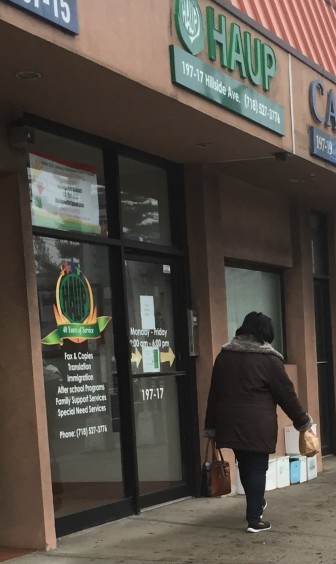
Nicole Ashley
Haitian Americans United for Progress in Hollis, Queens, sees many cases of immigrants trying to stretch their visa long enough to apply for a green card.
“Some people just get tired of renewing their visas and just find jobs off the books,” says Charles, 30. He also says that the process for applying for green cards is very detailed and takes time. “When immigration offices say that you need a justifiable reason to stay in the U.S., they mean that you have to show that you can sustain a living in America and exhibit a good character while you are here,” he added.
Marie, whose last name has been omitted to protect her status in this country, says that she applied for an extension but was denied. “I had to just take my chances and stay here illegally because I didn’t want to go back to Haiti,” says Marie. “Being in America is my dream.”
After several months of staying with her sister in Queens, Marie found a job in childcare, which provided her with a salary that was barely enough to support her daughter in Haiti. She says that she went from making a decent salary in Haiti to making almost nothing in America.
Marie Charles, the deputy director of HAUP, says that this is common for Haitian immigrants that are trying to get legalized. “They go from being doctors, lawyers and professionals in their country to coming to the U.S. and having to do the worst jobs,” says Charles. “It is a shock to them at first but they will take any job that they can get.”
In an effort to obtain a better job as a legal immigrant, Marie decided to enter into a green card marriage, a marriage between a legal resident and a person ineligible for residency. The moved led to financial problems, Marie says, and ended in divorce. She is still applying to get her green card after 15 years of living in the U.S. She says that even though she might be years away from becoming a citizen in this country, she remains optimistic that one day she will be able to truly live the American dream. “I am already working with an immigration attorney to gather letters of recommendation from people I worked for,” says Marie. “Therefore, it’s only a matter of time.”
Astoria serves as a haven for people fleeing Greece’s economic crisis
by Janae Hunter
As Greece enters its sixth year of a severe economic crisis, high unemployment rates and faulting banks have caused thousands of residents to move out of the country. Because Astoria Queens is already home to more than 14,000 Greeks, many have fled there to watch the crisis unfold from overseas.
“I came to open doors for my kids,” says Chris Bouloubasis, 55, a security guard and maintenance man at Agora Plaza, a Greek shopping mall in Astoria.
Bouloubasis had been living in Petra, a small island in northern Greece, for 22 years with his wife and kids. He says unemployment was low and the country was a “good place to raise kids and a family.” But in 2010, the crisis began and unemployment drastically. After he lost his job around 2013, he and his family packed up and moved to Astoria, a place Bouloubasis had called home some years before permanently settling down in Greece.
“If it was just me and my wife, we would have stayed, but our kids started university and the opportunities are much better for them here.” he says, adding that it’s especially hard for younger people to find jobs. As of November, unemployment for people between the ages of 25 and 74 was 23 percent, a 90 percent increase from November 2010.
Demetra Zegos, 40, an employee at Greek Superstore in Astoria, falls right in the age group most affected by the crisis.
“People who are a little bit before getting their social security are losing their jobs right before it kicks in, and kids right out of college are working at cafes or as sales people, and that’s if you can even find that.” she says.
Zegos left Greece for good around 2009 before the job market could get too bad, but still has family there who are attempting to ride the crisis out, including a sister who lost her job at a telecommunications company after 12 years. “I wouldn’t have a job right now if I was back in Greece.” Zegos says. “It’s very bad.”
Since the crisis began, 200,000 Greeks have moved out the country. While some people think the situation will continue to get worse, experts like Theodore Pelagidis, an economics professor at the University of Piraeus in Greece, says normalcy will return sooner than people think.
“Recovery will come by the end of next year but it will be slow and unequal.” he says in an email. “Greece is paying the price of not adjusting to the demands of global economy for many many years,” but, he added, “The situation is normal.”
Still, some people think the crisis is here to stay for the long run.
“In the next three to five years, I believe it will get worse,” says Bouloubasis. “They [Greece] owe a lot of money.”
Russian Cobbler One of the Last Still Standing in Queens Community
by Kazi Awal
A small boxy shoe repair shop can be found on the corner of Forest Avenue and Gates Street, in Ridgewood, Queens. The drab signage atop the storefront makes no attempts at being clever. “SHOE REPAIR,” it reads, in red block letters on a faded yellow backdrop. It is one of the only two remaining shoe repair stores in the neighborhood.
“When I first came here there were many,” says, Michael Akhunov, the cobbler, who runs the shop alone on most days, with only his 3-year-old pet parrot for company. “Four of them closed since I’ve been here.”
Short, scruffy, and with a modest grin, Akhunov, 45, is an immigrant from Russia—now Uzbekistan, since the dissolution of the Soviet Republic. Immigration has been a hot-button issue for many of the top candidates of the current presidential race and some of the rhetoric surrounding the issue has been derogatory.

Kazi Awal
Michael Akhunov at his shoe repair shop in Ridgewood, Queens.
“People say immigrants are lazy,” Akhunov, says with broken English and in an eastern European accent. “I’ve been doing this job since I was 12. I’ve worked since the day I got here.”
After mastering the craft in his home country, Akhunov came to New York City in 1996. He says he believed in the stories he heard of America as a land of opportunity and wanted to build a better life for himself in the states. Akhunov, jumped around several shoe repair stores across Brooklyn and Queens until he arrived where he is now and for or the last 16 years he has been at the helm of the Ridgewood relic.
“Some places are only Polish, or only Russian, or only something, you know?” says Akhunov. “I like this area because it’s very mixed. It feels alive.”
But the diverse neighborhood, like much of the rest of the city, has not been kind to the shoe-repair industry. Akhunov, attributed it to the proliferation of cheap shoes and uninformed customers, unaware of the quality of the products they are purchasing. He says he first noticed the decline around 10 years ago and that it has continued to decline since then.
“It’s a dying art. Some of the machines he uses are older than me,” says Bobby Raspiller, 60, a retired electrician, and a close friend of Akhunov’s. “But, this man, he’s a survivor.”
To keep the business afloat, Akhunov taught himself other skills and made them part of the business. He now also sharpens knives and fixes watches. He admits though, that, knife-sharpening requests are rare and that the majority of his business falls between watch repair and shoe repair.
“It’s hard for me to find shoes I like,” Nancy Ninnivaggio, 57, said at the store on a chilly Monday evening in November. “So it’s nice to get them repaired here. It’s convenient and this man does good work.”
Akhunov smiled graciously at Ninnivaggio’s comment. After she left, he went into the back and got a treat for himself and his parrot. When finished with his tidbit, the parrot squawked, “hello,” in the store now empty of customers.
*Correction: The initial version of this story identified Bacaycay as a personal chef. In fact, he has worked in restaurants.
City Limits is deeply grateful to CUNY professors Jan Simpson and Dana Roberson for their role shaping and editing this project.
Read more:
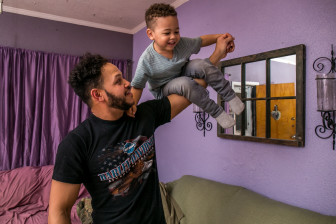 On the Border of Justice:
On the Border of Justice:Heavy Burdens and Unfair Fights in Immigration Courts
Far from the heated debate over immigration on the presidential campaign trail, the reality of U.S. policy plays out in immigration courthouses, where lawyers can be hard to come by, detention without a hearing is the norm and the judge you’re assigned can be the difference between deportation or a right to stay.


